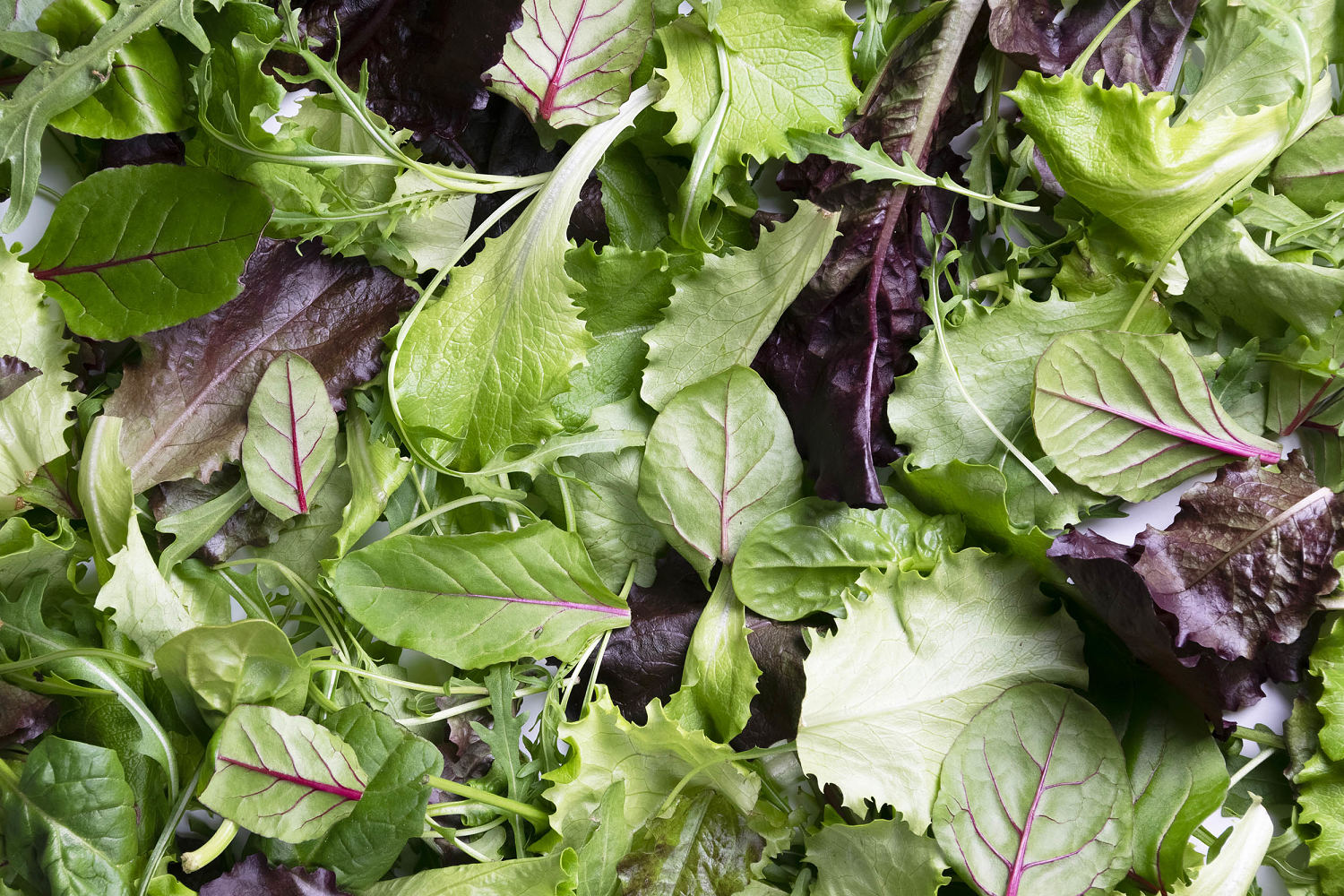Salads are often hailed as a health food, in large part due to their base: raw, leafy greens. Leafy greens are packed with nutrients, delicious, and an important part of a healthy diet. This superfood group of vegetables includes a variety of leaves in different colors, shapes and sizes.
At the grocery store, you'll find a wide selection of greens: from soft butter lettuce to spicy arugula, crunchy romaine and tender baby spinach. Which salad greens are the healthiest? We spoke to dietitians about the leafy greens with the most health benefits, which greens are the least nutritious, and how to build a healthier salad. Leafy greens are packed with vitamins, minerals and antioxidants, Amy Kimberlain, registered dietitian and spokesperson for the Academy of Nutrition and Dietetics, tells TODAY.

com. These include vitamins A, C, E and K; calcium; potassium; iron; magnesium; folate; carotenoids; and flavonoids — "all of which have been shown to be of benefit in reducing many chronic health conditions," Kimberlain adds. The health benefits of leafy greens include supporting the immune system, boosting heart and brain health, maintaining strong bones, fighting inflammation, protecting vision and more.
"They are also very low in calories, carbohydrates, fat, provide some protein and are a good source of fiber," Julia Zumpano, registered dietitian at the Cleveland Clinic, tells TODAY.com. Dietary fiber helps to prevent constipation and regulate blood sugar, and aids with weight loss.
Fiber also feeds good bacteria in the gut to support a healthy microbiome, . The recommends eating leafy greens at least several times per week. Generally, adults should consume two to three cups of vegetables per day, according to .
One serving of cooked vegetables is one cup, but one serving of raw, leafy salad greens is two cups, the experts note. "All leafy greens are healthy. Generally, the darker the green, the more nutrients it contains," says Kimberlain.
However, certain leafy greens taste better and are easier to eat raw in salads than others. "Mustard greens and collard greens, for example, are very nutritious but tend to be better tolerated cooked," says Zumpano. The experts recommend mixing up your salad greens when possible.
“The idea is to rotate leaves. ..
. Variety is important to ensure you’re getting a variety of nutrients,” says Kimberlain. Here are the leafy greens that pack the biggest punch nutritionally, according to dietitians: Spinach is delicious, versatile and incredibly nutritious — making it a top pick for salads among dietitians.
Spinach comes in mature and baby forms, which are similar nutritionally. Baby spinach is a more common choice for salads. According to the USDA Food Database, two cups of raw provides: Spinach is a superfood packed with vitamins A, C and K, as well as potassium, folate and magnesium.
Two cups of raw baby spinach provides 300 micrograms — more than twice your daily value — of vitamin K, which helps support blood clotting and bone health, according to . Spinach is also rich in antioxidants that are associated with a lower risk of chronic diseases, the experts note, and it's an excellent plant source of iron, a mineral essential for red blood cell production, . Kale is another favorite salad base among dietitians — especially baby kale, which is smaller and more tender but similar nutritionally to more mature varieties.
According to the USDA, two cups of raw provides: Kale belongs to the cruciferous family, a nutrient-dense group of vegetables. In addition to providing gut-healthy fiber and protein, kale is packed with , which helps strengthen the immune system, stimulates collagen production, and promotes healing. Two cups of raw kale provides 55 milligrams of vitamin C, or 60% of your daily value.
Kale is a good non-dairy source of calcium, which supports healthy bones and muscles, per the NIH. It also provides folate, manganese, antioxidants and flavanoids, . Arugula, sometimes called "rocket," is a peppery green that's rich in nutrients and low in calories.
According to the USDA, two cups of raw provides: Similar to other greens, arugula is rich in vitamin C, vitamin A, folate and magnesium. Arugula is another excellent source of vitamin K, providing nearly 20% of your daily value in a two-cup serving. Arugula is also packed with beneficial plant compounds and antioxidants.
One of these, glucosinolates, has been shown to have anti-inflammatory effects that may prevent various diseases and promote heart and brain health, . is a nutrient-dense cruciferous green with a spicy flavor. Often overlooked and harder to find in grocery stores, watercress is one of the healthiest vegetables you can eat, experts say.
According to the USDA, two cups of raw provide: A from the U.S. Centers for Disease Control and Prevention gave watercress a perfect 100% score on their scale of “powerhouse fruits and vegetables," .
Watercress is naturally rich in vitamin A from beta-carotene, as well as vitamin C and vitamin K. Additionally, plant compounds called phytonutrients in watercress may help benefit health conditions such as diabetes, , and cancer. Romaine is one of several varieties of lettuce, a leafy green that has a lighter color and crisp texture.
It's also packed with nutrients — so Caesar lovers, rejoice. According to the USDA, two cups of raw provides: Romaine lettuce is rich in vitamins A and K, as well as calcium, potassium, iron and magnesium, the experts note. Romaine is also a great source of beta-carotenes, the precursor to vitamin A and a powerful antioxidant that supports eye health and protects the cells from free radicals, .
Two cups of romaine provides about 5,000 micrograms of beta-carotenes, well above the daily value, per the . All leafy greens are healthy, but some have fewer nutrients than others, says Zumpano — especially one in particular. Iceberg lettuce often gets a bad rap for being devoid of nutrients and mostly water.
While there is some truth to this, iceberg can still be part of a healthy diet, the experts note. According to the USDA, two cups of chopped provides: When stacked up against the other greens, iceberg is significantly less nutrient-dense. "However, iceberg lettuce does contain some folate and vitamin A, and it is super hydrating," says Kimberlain.
Iceberg lettuce is more than 95% water, and eating can help increase your daily fluid intake. While it's fine to enjoy iceberg lettuce, the experts recommend mixing things up and adding nutrient-dense greens when possible. Leafy greens are safe for most people to eat every day, says Zumpano.
However, certain people need to watch their intake. “An increase in leafy green consumption is contraindicated in patients taking anticoagulant medications (blood thinners),” says Kimberlain, adding that the high levels of vitamin K can interfere with these drugs and decrease their effectiveness. If you have any underlying conditions or take medications, always talk to your doctor before changing your diet.
Many leafy greens contain pesticides. “Organic doesn’t mean ‘pesticide free,’ but both conventional and organic are within the level for safe consumption,” Kimberlain notes. Leafy greens have also been associated with outbreaks of food borne illness, such as E.
coli, per . All fresh greens should be washed before eating to reduce the amount of microorganisms and chemicals. A quick soak in water with baking soda, lemon or vinegar, can also help clean greens, says Zumpano.
"If convenience is important to you, precut, prewashed leafy greens can be an excellent choice,” Kimberlain adds. What you add — or don't add — to a salad can make a big difference in terms of taste and nutrition. When choosing , Zumpano recommends opting for whole, nutritious foods, such as: The provide some nutrients and contain minimal sodium, added sugar and saturated fat, the experts note.
These include: Caroline Kee is a health reporter at TODAY based in New York City..


















